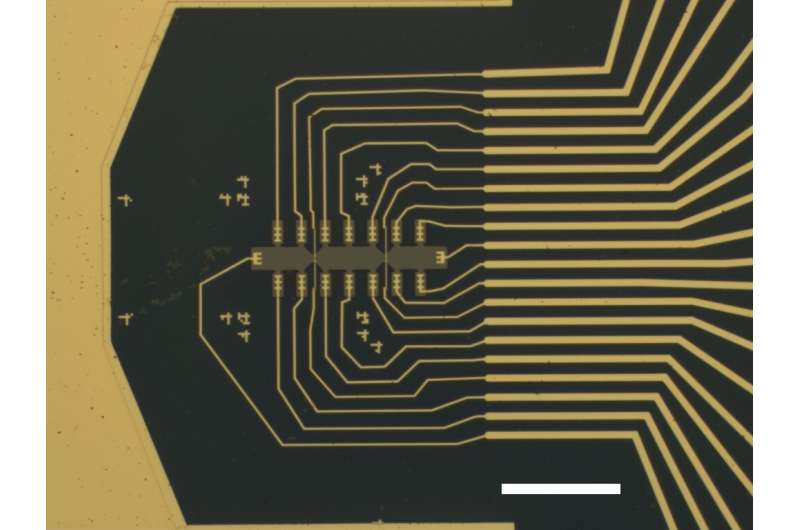July 19, 2023 feature
This article has been reviewed according to Science X's editorial process and policies. Editors have highlighted the following attributes while ensuring the content's credibility:
fact-checked
peer-reviewed publication
trusted source
proofread
New gate-tunable and high-mobility devices based on strontium titanate

Strontium titanate (SrTiO3), an oxide of strontium and titanium with a perovskite structure, has many advantageous properties, including spin-orbit coupling, electrical tunability, and unconventional superconductivity. Compared to the superconductivity of conventional metals, such as aluminum or niobium, the superconductivity of SrTiO3 persists at low electron densities, at which it can be controlled via the application of electrical voltages.
The unique properties of SrTiO3 make it a promising material for the development of quantum technologies. Yet the development of these devices has so far proved fairly challenging, due to the high levels of disorder in SrTiO3 nanostructures.
Researchers at Stanford University, the SLAC National Accelerator Laboratory, and other institutes recently realized new gate-tunable devices based on SrTiO3 that exhibit a high electron mobility. These devices, introduced in a paper published in Nature Electronics, can transport quantized charge, which could have valuable implications for the development of SrTiO3-based quantum technology.
"We wanted to learn how to make nanometer-scale narrow channels in SrTiO3," Evgeny Mikheev, one of the researchers who carried out the study, told Tech Xplore. "This material is both technologically and scientifically interesting because of its unusual superconductivity, which at low densities can be controlled by applying voltages to gate contacts inside transistor-like structures.
"Our main objective was to make devices with sufficiently low amounts of defects and impurities ('disorder') to get into the regime where electrons ballistically flow through a narrow constriction without colliding with defects. In very clean samples, this can lead to quantized charge transport through discrete ballistic channels. This is clearly observable as steps between plateaus in electrical conductance data shown in our paper."
The devices realized by Mikheev and his colleagues have a unique design carefully studied to enable quantized charge transport via discrete ballistic channels. They are based on SrTiO3 2D electron gas channels and an ionic liquid gate, divided by a thin hafnium oxide barrier layer.
"Our study builds on two previous works by David Goldhaber-Gordon's group," Mikheev explained. "The first is my previous paper published in 2021, in which we reported a narrow constriction in strontium titanate. It was made by creating a 2D electron gas on the surface of SrTiO3 with a technique called ionic liquid gating. The ionic liquid is locally 'shadowed' from strontium titanate with a nanopatterned gate contact, creating the constriction. The aspect we wanted to improve upon in this study was in reducing disorder."
To reduce the disorder in SrTiO3. Mikheev and his colleagues devised a solution that builds on an earlier study carried out by David Goldhaber-Gordon's group and led by Patrick Gallagher, focusing on ionic liquid gated SrTiO3 devices. These devices were too wide to exhibit any ballistic quantization effects. However, the team found that by inserting a very thin layer of hexagonal boron nitride between the ionic liquid and SrTiO3 , they could significantly reduce disorder and impurities in the devices.
"The process based on thin hexagonal boron nitride flake exfoliation employed by Goldhaber-Gordon's group in 2015 is not compatible with the nanoscale patterning process used in our 2021 study," Mikheev said. "In the Nature Electronics work, we were able to replace boron nitride with hafnium oxide deposited by atomic layer deposition, a more straightforward and easily reproducible process to make a very thin barrier. The new process achieved a similar reduction in disorder, while also allowing us to add nanoscale device features."
Using their design strategy, Mikheev and his colleagues were able to create gate-tunable and high-mobility devices based on SrTiO3 that can transport quantized charge. In the future, their work could serve as a blueprint to develop new nanodevices with quantum transport using SrTiO3, which could in turn contribute to the creation of promising superconducting or topological qubits.
"My long-term plan is to develop this material into a quantum information technology platform, or a component of one," Mikheev added. "There are also several intriguing unresolved open scientific questions from this work. One is the origin of 'Y-shaped' sub-bands, which do not show spin splitting until very high magnetic fields. This is an unusual feature that was also observed by Jeremy Levy's group at University of Pittsburgh in a different type of nanodevice based on SrTiO3. We don't yet understand its origin, but we hope to elucidate it in follow-up experiments."
More information: Evgeny Mikheev et al, A clean ballistic quantum point contact in strontium titanate, Nature Electronics (2023). DOI: 10.1038/s41928-023-00981-5
© 2023 Science X Network


















